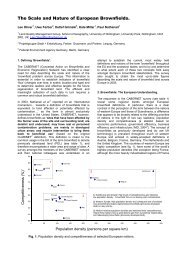Sustainable Brownfield Regeneration: CABERNET Network Report
Sustainable Brownfield Regeneration: CABERNET Network Report
Sustainable Brownfield Regeneration: CABERNET Network Report
Create successful ePaper yourself
Turn your PDF publications into a flip-book with our unique Google optimized e-Paper software.
5.3 • initiate the development/creation of the significant symbols and<br />
connotations of structural elements,<br />
• create new progressive interesting architecture, preserved technical works,<br />
or natural complexes in the locality of the brownfield,<br />
• promote the development of public spaces in the area, including<br />
greenspace,<br />
• to extend the master plan with a design guide for urban design,<br />
• preserve valued elements of existing cultural heritage, underlying positively<br />
perceived specific features and architectural quality of the redeveloped<br />
structure.<br />
Principle 6. Contribute to strategic sustainability objectives in the urban<br />
context<br />
The redevelopment should be in line with existing policies on sustainability. People<br />
should be able to work, live and play in the area if they chose to do so, thus minimising<br />
travel between these activities. Mixed use can be difficult to achieve as it depends on<br />
the developer’s plan and in the case of the company’s imperative to make profit, the<br />
developer is likely to seek the highest value use in all cases, often at the cost of the<br />
long-term viability of the development. A strategic decision has to be taken in the<br />
process of preparing land use plans that the area can be developed, with the local<br />
authority exercising control on each site. Thus the authority will be able to take a<br />
balanced view between financial returns and long term sustainability.³⁵<br />
This objective can be achieved largely through good spatial and land use planning<br />
techniques. However, supportive legislation is required which puts the onus on<br />
developers to reuse brownfield sites before greenfields. The redevelopment should<br />
not rely only on private car transport for access because of the lack of planning and<br />
investment in public transport. It should be predicated on the provision of public<br />
transport and seek to integrate with the developing proposals for such transport. It is<br />
necessary to concentrate on:<br />
• avoiding all brownfield regeneration projects looking the same<br />
• avoiding the development of mono-functional structures in the process of<br />
regeneration,<br />
• supporting mixed ownership/investments in the locality of brownfield,<br />
• creating viable public services and public transport,<br />
• connecting the newly developed local economy to the variety of hierarchic<br />
levels of market (local, regional, national, international).<br />
³⁵ Please refer to the <strong>CABERNET</strong> Case Study of the Third Level College, Dublin Docklands, which was given a site free of<br />
charge on condition that it provided particular courses suitable for the local communities and that it reserved a number<br />
of places for local students who might not have the normal, minimum academic entry requirements. Further details at:<br />
www.cabernet.org.uk<br />
74






